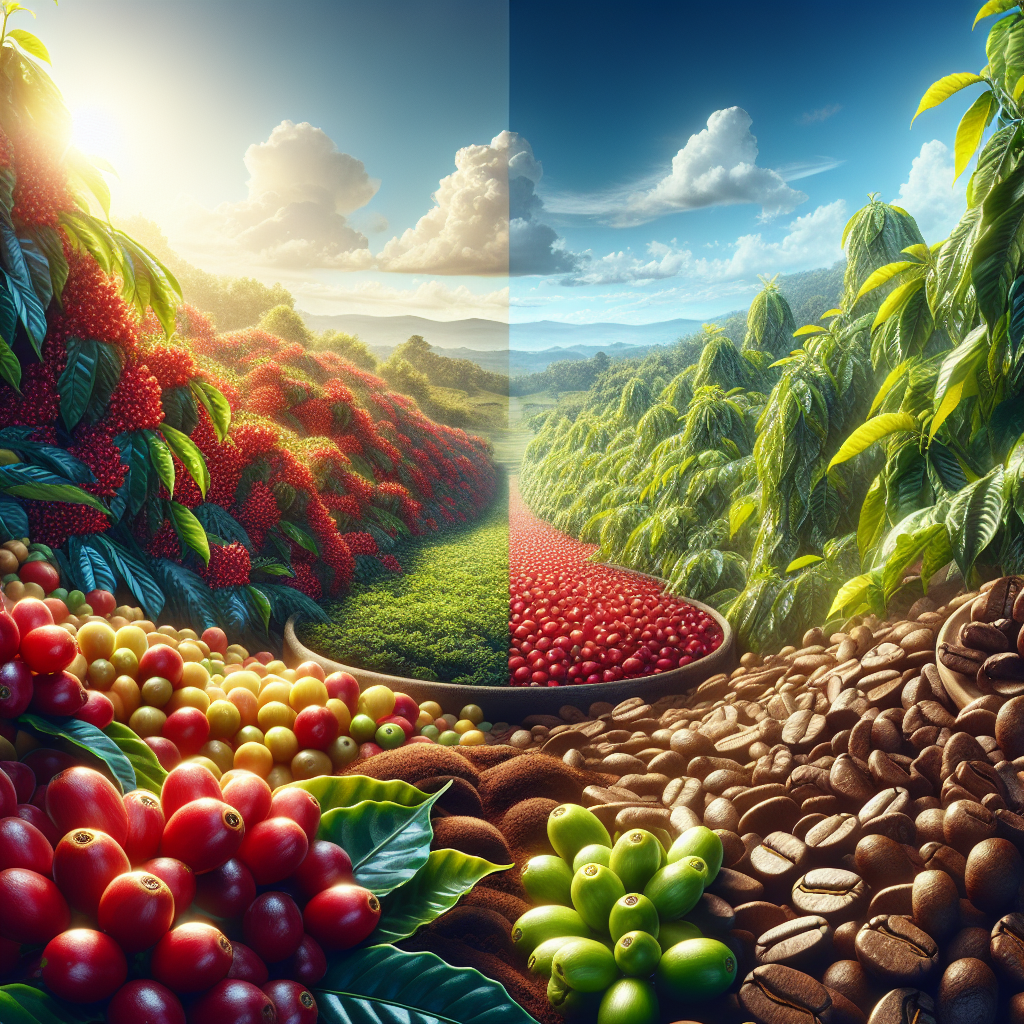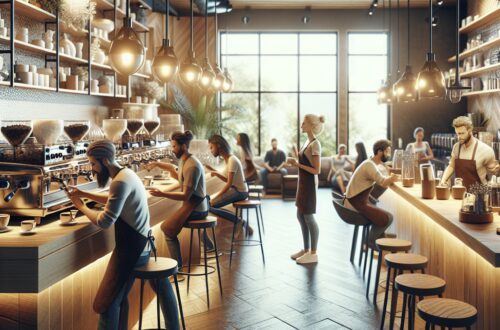“`html
Arabica vs. Robusta Coffee Beans: Key Differences
When it comes to choosing coffee, one of the most common questions people ask is: what is the difference between Arabica and Robusta coffee beans? Although both types of beans share some similarities, they differ in many aspects, including flavor, caffeine content, growing conditions, and more. This guide will comprehensively break down the distinctions between these two popular coffee varieties.
To help you better understand the differences, here is a table showing the caffeine content, taste impact, and health implications of both types of beans:
| Type of Coffee Bean | Caffeine Content (mg per 8 oz) | Taste Impact | Health Implications |
|---|---|---|---|
| Arabica | 95 | Smoother flavor profile | Lower caffeine may be preferable for sensitivity |
| Robusta | 200 | Bitter, punchy taste | Higher caffeine provides a stronger boost |
Caffeine Content in Arabica vs. Robusta
Caffeine is one of the most talked-about factors when comparing Arabica and Robusta beans. Here’s what you need to know:
- Arabica Coffee Beans: Lower caffeine content, generally containing about half the caffeine of Robusta beans.
- Robusta Coffee Beans: Higher caffeine content, contributing to a punchier and more bitter taste.
- Taste Impact: The lower caffeine content in Arabica contributes to its smoother flavor profile.
- Health Implications: Lower caffeine in Arabica may be preferable for those sensitive to caffeine.
- Energy Boost: Robusta is often chosen for a higher caffeine boost.
- Flavor Profile: Higher caffeine makes Robusta taste more bitter and robust.
- Market Appeal: Arabica’s lower caffeine makes it preferable in specialty coffees for a refined taste.
- Caffeine Effect on Plant: Higher caffeine in Robusta acts as a natural pesticide, making the plants more resilient.
Flavor Profile: Comparing Arabica and Robusta
The taste is perhaps the most noticeable difference for coffee lovers.
- Arabica Beans: Known for their sweeter, smoother, and more aromatic flavor.
- Robusta Beans: Possess a stronger, harsher flavor often described as earthy or woody.
- Aroma: Arabica tends to be more fragrant and complex.
- Flavor Notes: Arabica often has fruity or zesty notes.
- Bitterness: Robusta is more bitter due to higher caffeine and chlorogenic acids.
- Acidity: Arabica has higher acidity, contributing to its vibrant flavor.
- Mouthfeel: Arabica beans typically result in a cleaner and lighter mouthfeel.
- Blending: Robusta is often used in blends for added strength and crema, especially in espressos.
Cost and Quality: Economic Factors
There is also a significant economic difference between Arabica and Robusta beans.
- Arabica Beans: Generally more expensive due to higher quality and demand.
- Robusta Beans: Cheaper, making them more accessible for budget consumers.
- Market Share: Arabica makes up about 75-80% of global coffee production.
- Production Yield: Lower yield for Arabica due to higher growing conditions.
- Cost of Cultivation: Higher for Arabica due to more delicate growing needs.
- Supply and Demand: High demand and lower supply of Arabica beans drive up prices.
- Quality Perception: Arabica is often associated with premium and specialty coffees.
- Buying Choices: Consumers willing to pay more often opt for Arabica for the quality experience.
Physical Characteristics of Arabica vs. Robusta Beans
Even visually, Arabica and Robusta beans are notably different.
- Arabica Beans: Oval in shape, flatter, with a distinct curved groove.
- Robusta Beans: Smaller, rounder, and stubbier with a straighter groove.
- Bean Size: Robusta beans are generally smaller.
- Shape and Structure: Arabica features a more elongated shape.
- Groove Pattern: The groove in Arabica beans is curved, while in Robusta it is straight.
- Bean Texture: Arabica beans tend to be smoother in texture.
- Bean Density: Robusta beans are denser and harder.
- Aesthetic Appeal: The diverse visual elements provide a clue about the type and quality of coffee.
Growing Conditions for Arabica and Robusta
The environmental needs and resilience of these coffee plants differ markedly.
- Arabica Plants: Thrive at higher altitudes, typically between 2,600 and 6,000 feet.
- Robusta Plants: Grown at low altitudes, up to 600 meters.
- Temperature Preferences: Arabica benefits from cooler temperatures.
- Pest and Disease Resistance: Robusta is more resilient to pests and diseases.
- Climate Sensitivity: Arabica is more affected by environmental factors.
- Drought Resistance: Robusta plants are more drought-resistant.
- Soil Requirements: Arabica requires richer, well-draining soils.
- Environmental Effects: Climate change impacts Arabica more due to its specific growing needs.
Plant Structure and Genetic Differences
The genetic and structural differences between Arabica and Robusta plants also play a crucial role.
- Arabica Plants: Typically smaller and require more specific care.
- Robusta Plants: Sturdier and more drought-resistant.
- Genetic Makeup: Arabica is a hybrid of two species.
- Robusta’s Genetic Stability: Features a simpler, but more robust genetic structure.
- Complexity in Flavor: Arabica’s hybrid nature contributes to a rich flavor profile.
- Growing Challenges: Arabica’s genetic makeup makes it more susceptible to diseases.
- Yield Consistency: Robusta tends to provide a more consistent yield.
- Breeding History: Arabica’s elongated breeding history contributes to its varied flavor nuances.
Both Arabica and Robusta coffee beans offer unique advantages and cater to different taste preferences and market needs. Understanding these differences can enhance your coffee selection process, be it for personal enjoyment or business purposes.
By delving into factors such as caffeine content, flavor profile, cost, physical characteristics, growing conditions, and genetic differences, you can make an informed choice and appreciate the qualities that each type of coffee bean brings to your cup.
“`
Shop at Breville now!
https://breville.oie8.net/oqDqrE
Shop Coffee Machine at Amazon now!
Click here!





